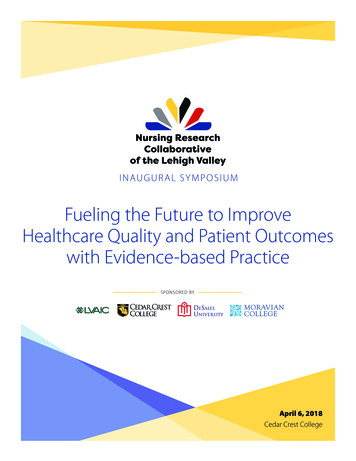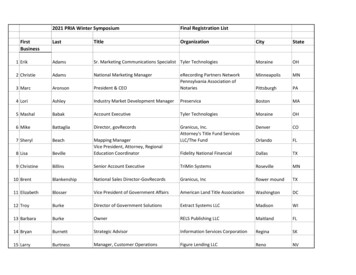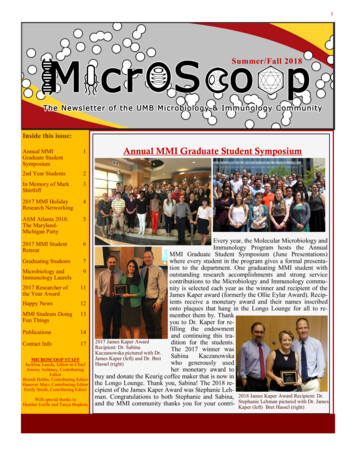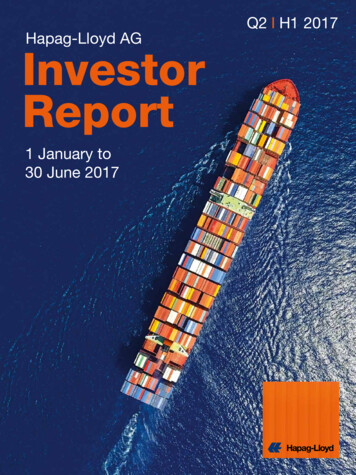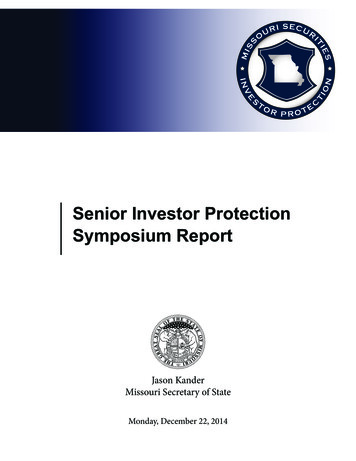
Transcription
RIESTOTIINVONMIESSSI SECUTIOURR PROTESenior Investor ProtectionSymposium ReportJason KanderMissouri Secretary of StateMonday, December 22, 2014C
CAPITOL OFFICEROOM 208(573) 751-2379JASON KANDERSECRETARY OF STATESTATE OF MISSOURIJAMES C. KIRKPATRICKSTATE INFORMATION CENTER(573) 751-4936Fellow Missourians:My office works tirelessly to protect Missourians’ hard-earned savings by investigating casesof financial fraud and bringing actions against those who scam our friends and neighbors. Weeducate the public on safe investing by speaking with various organizations throughout the stateand through our public service announcements. We’re making progress, but there is still morework to be done to protect Missouri investors.Immediately following my election as Secretary of State, I met with representatives fromtop financial firms based in Missouri. We all agreed one of the most vital tasks of my office’sSecurities Division was to work closely with the financial services industry to protect Missouriseniors and their life savings.On October 8, 2014, I convened our first Senior Investor Symposium to address the issue offinancial exploitation of senior investors, particularly those suffering from cognitive decline. Thesymposium brought together financial industry representatives, medical experts, policymakersand senior advocates for the first time. Each spoke to the unique challenges they face inaddressing this issue and offered solutions for ways we can work together to prevent fraud.I’m pleased to present this report, which details the presentations heard at the symposium andexplores ways to help Missouri move forward in preventing elder financial abuse.Sincerely,Jason Kander
PANELISTSJason KanderMissouri Secretary of StateCraig EichelmanState Director, AARPDavid MinnickGeneral Counsel, StifelScott GoldeGeneral Counsel, ScottradeDoug KellyAssistant General Counsel, Wells Fargo AdvisorsCarroll RodriguezChief Operating Officer, Alzheimer’s Association St. Louis ChapterPRESENTERSPage UlreySenior Deputy Prosecuting Attorney, King County, WashingtonDr. John MorrisHarvey A. and Dorismae Hacker Friedman Distinguished Professor of NeurologyWashington University-St. LouisKathryn SappBureau Chief, Division of Senior and Disability Services, Missouri Department ofHealth and Senior ServicesAnneliese StoeverInformation & Assistance Coordinator, St. Louis Area Agency on AgingAndy BlockerExecutive Vice President, Public Policy and AdvocacySecurities Industry and Financial Markets Association (SIFMA)1
EXECUTIVE SUMMARYSeniors are an increasingly attractive target for those who commit financial fraud. Our seniors,a large and growing segment of our population, tend to have greater financial resources thanyounger generations, and are more likely to face losses in cognitive ability.Nationally, baby boomers control nearly 13 trillion in investable assets,1 and by 2030 they willbe in the 65 years or older segment of our population. The number of Americans over the age of65 will rise from 40 million in 2010 to 72 million in 2030, representing nearly 20 percent of thepopulation in the United States.2I SECURRUOITISSIn Missouri, the population trends are similar. According to the Missouri Senior Report, in 2011there were 865,652 seniors in the state of Missouri, comprising 14.2 percent of the population.By 2030, this number is expected to be 1,413,266 and represent 21 percent of Missouri’s entirepopulation.3MIESThe risk of diminished mental capacity increases with age. The Geriatric Mental HealthFoundation estimates 4 million Americans currently suffer from Alzheimer’s disease or arelated form of dementia. In Missouri, more than 110,000 individuals are currently living withAlzheimer’s or related dementia. By 2025, that number will be more than 130,000.4ONINVUnfortunately, losses in cognitive ability often take time to diagnose, making elder financialabuse particularly difficult to recognize and causing many cases to go unreported. But byworking together, the financial services industry, senior advocates and other agencies serving ourseniors can more effectively identify and combat elder financial abuse.ESTOTIBy bringing together top financial industry representatives, experts in the field of cognitivedecline, state enforcement and regulatory agencies, and senior citizen advocates, the SeniorInvestor Protection Symposium provided a unique opportunity to examine the issue of elderfinancial abuse in a collaborative way.TECThe symposium included discussions of existing practices and highlighted efforts in other statesas policy recommendations. The secretary of state’s office will continue to work with senioradvocates, financial services industry professionals and lawmakers to develop policy solutions tofurther protect Missouri seniors.R PROSEC, NASAA and FINRA, “Protecting Senior Investors: Compliance, Supervisory and other practices used byfinancial services firms in serving senior investors.” September 22, 2008. Accessed October 12, 2014. cesreport092208.pdf2Vincent, Grayson K. and Victoria A. Velkoff, 2010, THE NEXT FOUR DECADES, The Older Population inthe United States: 2010 to 2050, Current Population Reports, P25-1138, U.S. Census Bureau, Washington, DC.3Missouri Senior Report is published by the University of Missouri Office of Social and Economic Data Analysis(OSEDA) and University of Missouri Extension in collaboration with the State of Missouri Department of Healthand Senior Services (DHSS).4Missouri Alzheimer’s State Plan Task Force. November 2010. Accessed October 16, 2014. http://www.alz.org/stl/documents/Final Report.pdf12
SESSION 1 SUMMARYPresenter: Page Ulrey, Senior Deputy Prosecuting Attorney, King County, Washington5Elder financial exploitation: A growing crisisSenior investors control an incredible amount of assets, and transfers of these assets occur everyday. In fact, 18 trillion or more will move between the generations in the next 20 years.6 Duringthat time, 10,000 people will turn 65 every day,7 and 20 percent will be victims of financialexploitation.OI SECURRUITIMIESSSUnfortunately, victims often do not report elder financial abuse. Many seniors fear losingindependence if they report financial exploitation, while others worry about retaliation by aperpetrator. Often the perpetrators have close ties to the victim. Many victims have an emotionaldependence on a perpetrator, and retaliation may be as simple as no longer having a visitor orassistance in daily activities. The emotional dependence or close relationship of an abuser mayalso contribute to a lack of awareness or disbelief that exploitation is happening. Finally, manyvictims suffer from dementia or some kind of cognitive impairment, which further contributes toa lack of knowledge that exploitation is occurring.Perpetrators often hold positions of trustCaregivers, family members or close friends can sometimes be the perpetrators of elder financialabuse. A fiduciary or other person in a position of trust or a stranger who targets seniors anddevelops a trust relationship can also perpetrate elder financial abuse.ONESTIINVBecause of the trust relationship between the perpetrator and the victim, perpetrators are oftenable to take advantage of their victims through abuse of fiduciary relationships, intimidation,deception and undue influence—a pattern of manipulative behaviors aimed at “grooming” avictim to release assets to a perpetrator. This generally involves victims who are isolated, lonelyand vulnerable.Barriers to financial services industry reportingFinancial industry professionals can be among the few defenders of a possible victim of elderfinancial abuse. Many have long term relationships with clients and are aware of normal clientbehavior. For seniors who are isolated, a financial advisor or broker-dealer may be the personmost likely to identify uncharacteristic financial behavior. But financial industry professionalsface barriers in reporting suspected elder financial abuse. It is difficult to distinguish betweenTOR PROTECIn 2001, the King County Prosecutors office formed the elder abuse project to prosecute cases of elder financialexploitation, neglect, sexual assault and homicide. They train first responders, the medical community and publicworks to improve systemic response to elder abuse.6Sarbjit Nahal and Beijia Ma, equity strategists at Bank of America Merrill Lynch, expect a 12 trillion transferfrom those born in 1920s and 30s to baby boomers. However, Boomers are expected to transfer an additional 30trillion in assets to their heirs over the next 40 years. Mamta Badkar. “We’re On The Verge Of The Greatest TransferOf Wealth In The History Of The World” Business Insider. June 12, 2014. Accessed October 16, er-of-wealth-in-history-2014-6#ixzz3GPTn7Nf77over the next 19 years, according to the Pew Research Center: s-retire/53
financial exploitation or free choice. There is a lack of adequate screening tools to determine thecapacity of an investor. Training employees on this topic is more difficult at smaller firms withfewer resources. And firms can be fearful of intruding upon client’s privacy and fearful of liability.Criminal enforcementConsider this example from King County, Washington: The perpetrator was a longtime agent foran insurance company who targeted five of her most vulnerable clients. They were elderly, livedalone and some had mild dementia. She developed a trust relationship with them over time, andtold her victims their annuities were maturing. The perpetrator instructed her victims to writechecks to her for “reinvestment,” and stole a total of 1,052,000. She was charged with multiplecounts of felony theft in King County Superior Court and pleaded guilty to 10 counts of theft inthe first degree and vulnerable victim aggravators. She was sentenced to 75 months in prison.I SECURTaking an elderly person’s assetsUby abuse of fiduciary relationship,undue influence, intimidationRor deception is also a crime Ounder Missouri law.IBut criminal prosecutions of elder financial abuse cases are often quite difficult to pursue. TheyTISS8MIESare multifaceted, often involving powers of attorney, guardianships, trusts, wills and nebulousconcepts of capacity and undue influence.ONINVRSMo. 570.145. 1. A person commits the crime of financialexploitation of an elderly or disabled person if such person knowinglyby deception, intimidation, undue influence, or force obtains controlover the elderly or disabled person’s property with the intent topermanently deprive the elderly or disabled person of the use,benefit or possession of his or her property thereby benefitting suchperson or detrimentally affecting the elderly or disabled person.9ES9TOTIDue to the criminal code revisions, the language will change to the following on January 1, 2017: 570.145. 1.A person commits the offense of financial exploitation of an elderly person or a person with a disability if suchperson knowingly obtains control over the property of the elderly person or person with a disability with the intentto permanently deprive the person of the use, benefit or possession of his or her property thereby benefitting theoffender or detrimentally affecting the elderly person or person with a disability by:(1) Deceit;(2) Coercion;(3) Creating or confirming another person’s impression which is false and which the offender does not believe to betrue;(4) Failing to correct a false impression which the offender previously has created or confirmed;(5) Preventing another person from acquiring information pertinent to the disposition of the property involved;(6) Selling or otherwise transferring or encumbering property, failing to disclose a lien, adverse claim or other legalimpediment to the enjoyment of the property, whether such impediment is or is not valid, or is or is not a matter ofofficial record;(7) Promising performance which the offender does not intend to perform or knows will not be performed. Failure toperform standing alone is not sufficient evidence to prove that the offender did not intend to perform; or(8) Undue influence, which means the use of influence by someone who exercises authority over an elderly personor person with a disability in order to take unfair advantage of that person’s vulnerable state of mind, neediness,pain, or agony. Undue influence includes, but is not limited to, the improper or fraudulent use of a power of attorney,guardianship, conservatorship, or other fiduciary authority.8R PROTECLaw applies to those 60 years and older as well as vulnerable adults 18–59 years of age.4
A complete knowledge of these concepts is important for investigation and prosecution, butrarely are they addressed within a criminal law framework. Most cases of elder financial abuserequire compilation and analysis of complete financial records, but few criminal investigatorshave the specialized financial background to be able to properly explore possible crimes.As a result, these cases are often pushed into civil court, if they are pursued at all. Still, very littlecoordination exists between the financial services industry, health care providers, social servicesprofessionals and the civil legal system.I SECURRUI—PAGE ULREY,SENIOR DEPUTYPROSECUTING ATTORNEYESMIO“WE FIND FINANCIALEXPLOITATION TO BE THEMOST COMMON OF ANYELDER ABUSE WE SEE.”TISSThe financial services industry is crucial in this fight.The industry is keenly aware of the importance ofseniors having assets sufficient to carry them throughretirement. Broker-dealers and investment advisorscan also be keenly aware of clients’ susceptibilityto exploitation, and may have occasion to witnesstroubling interactions between clients and potentialscammers. Finally, financial industry professionalsmight be the only third party aware of a depletion ofclient assets.Washington state passed legislation that acknowledges the integral role of the financial industryand empowers financial professionals to help prevent elder financial abuse. The Abuse ofVulnerable Adults Act (RCW 74.34) includes the following key elements:ES 10TOTIONAllows financial institutions to: Report to the Washington State Department of Social and Health Services(DSHS) or local police when there is reason to believe a vulnerable adult isbeing or has been abandoned, abused, financially exploited or neglected Share complete records with DSHS, law enforcement and prosecutors whenfinancial exploitation (FE) is suspected Freeze assets of suspected exploiters or victims Avoid civil liability when acting in good faithConsiders employees of financial institutions, attorneys and volunteers who workwith elders permissive reporters of elder financial abuseRequires training on elder and vulnerable adult financial exploitation for employeesof financial institutions, broker-dealers and investment advisers10INV R PROTECConducted by the Washington attorney general’s office5
SESSION 2 SUMMARYPresenter: Dr. John Morris, Washington University in St. Louis, Harvey A. and DorismaeHacker Friedman Distinguished Professor of NeurologyCognitive decline, dementia and Alzheimer’s diseaseMany older individuals age with their cognitive abilities generally intact. They remain independentand able to execute daily activities. This is because aging itself is not the cause of cognitivedecline; rather, it’s the diseases that sometimes accompany aging that cause cognitive decline.OI SECURRUITIMIESSSDementia affects both memory and executive function. Real-world examples of difficulty inexecutive function are the inability to learn new technology, difficulty driving and inabilityto make financial decisions. Often family members first notice a change in either memory orexecutive function, but these changes are subtle and individualized. In fact, very few peoplerecognize dementia-related changes in themselves.In early stages, for example, it’s possible for anindividual suffering from cognitive decline tomost daily tasks with little interference, but“ [THOSE WITH COGNITIVE performmore complicated and technical tasks—like drivingDECLINE] WILL BE AT RISK or managing personal finances—become much moreFOR POOR JUDGEMENT,difficult.DECISIONS ANDINAPPROPRIATE ACTIVITY.”INVON—DR. JOHN C. MORRISMedically, dementia occurs when a person hasdeclined in their cognitive abilities to the point itinterferes with his or her ability to execute dailyactivities. It’s almost always progressive and can bequite deceptive.ESTOTIIt is difficult to pinpoint the moment when dementia begins. Generally the losses in cognitiveability are very subtle. It often takes years before it becomes obvious the losses are progressive,which makes it even more difficult to detect.TECAlzheimer’s, the most common cause of dementia,11 is a disease of select brain cells. Humanshave brain cells specialized for a number of purposes: vision, movement, sensation andcognition. Cognitive cells are responsible for a variety of functions, including memory,judgment, attention, personality and language. These are the most developed brain cells in theentire animal kingdom, and the cells most vulnerable to Alzheimer’s. Cognitive cells deteriorateand die over an extended period of time, which is why early signs of Alzheimer’s—and dementiamore broadly—are so subtle.R PROThis period of deterioration and death of cells can go undetected for 20–25 years beforenoticeable symptoms develop.1180 percent of dementia is caused by Alzheimer’s.6
SESSION 3 SUMMARYPresenter: Kathyrn Sapp; Bureau Chief, Division of Senior and Disability Services,Missouri Department of Health and Senior ServicesDHSS’ role in addressing the problem of elder abuseThe Department of Health and Senior Services (DHSS) is the primary state department thatinvestigates elder abuse cases in Missouri. Within DHSS, the Division of Senior and DisabilityServices is mandated to carry out and oversee programs designed to maximize individuals’independence. It has 217 field staff around thestate and maintains an elder abuse hotline,12 which“[FINANCIAL] ADVISORSreceived 23,000 calls in 2013.MICONTACT WITH A CLIENT.”—KATHRYN SAPP, DHSSES 195 million annually, with an average of 11,000lost per victim.TISSI SECMAYHAVE PIECES OF THEURDHSS has found elder financial Uabuse to bePUZZLER THAT WE AREN’Tsignificantly underreported. ODHSS estimatesI FROM OURABLE TO GLEANfinancial losses among the elderly in Missouri areONINVElder abuse investigationsThe Division of Senior and Disability Services has a special investigatory unit that explores allreports of elder abuse, neglect and exploitation. DHSS has found that because of its complexity,elder financial abuse is one of the most difficult types of abuse to investigate. Often, this kindof exploitation is multi-jurisdictional and requires assistance from multiple agencies, includingfrom the financial industry.SESSION 4 SUMMARYESTOTIPresenter: Anneliese Stoever, Information and Assistance Coordinator, St. Louis AreaAgency on AgingTECSt. Louis Area Agency on Aging (SLAAA) is 1 of 10 Area Agencies on Aging that provideservices in Missouri, and 1 of 600 across the United States. It is funded federally through theOlder Americans Act, DHSS and other grants. It oversees programs such as Meals on Wheelsand provides health screenings, educational programming and some transport services.R PROElder financial abuse observed by SLAAASLAAA also assists seniors in transitioning from their homes to senior living facilities. Considerthis example of elder financial abuse observed by SLAAA:SLAAA client “Tom”13 had a home falling down around him and was unable to fix it himself.12131-800-392-0210: The hotline is staffed 365 days a year.Name has been changed.7
He arranged to have it repaired. When it became clear the house needed much more than a fewroof repairs, Tom decided to move into senior housing. SLAAA helped To
Financial industry professionals can be among the few defenders of a possible victim of elder financial abuse. Many have long term relationships with clients and are aware of normal client behavior. For seniors who are isolated, a financial advisor or broker-dealer may be the person most likely to ident

